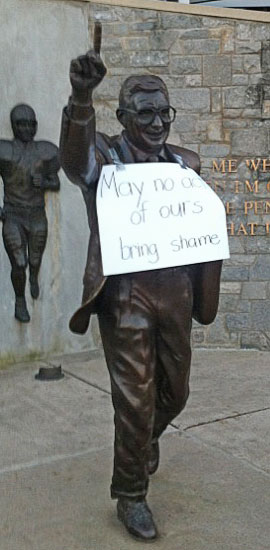One of the most contentious aspects of conference expansion is the formation of divisions, and how to properly accommodate the often competing interests of traditional rivalries, competitive balance, and geographic logic. Â (Although, in a world where San Diego State will soon be in the same conference as Connecticut, that last one has become kind of laughable.) Â With these things (and others) in mind, the Big Ten added Nebraska a year ago and attempted to create divisions that would produce satisfying championship games without trampling too much on tradition (something that few in the college football universe care about anymore) in the process.
The result was the highly controversial and unfortunately named “Legends and Leaders” format. Â While most fans and observers (and even Jim Tressel) favored the simple East/West split along the Indiana-Illinois border, the Big Ten brass seemed to specifically desire a separated Ohio State and Michigan, for the obvious benefit of being able to stage The Game as a conference title matchup. Â This decision, of course, infuriated fans of these teams, who were suddenly worried that perhaps the single most traditional thing in the conference was about to be seriously messed with.
And yet, in its first season, the success of the Legends/Leaders set-up is undeniable. Â The championship game featured the two best teams in the conference in a high-scoring, back-and-forth rematch of the season’s most exciting game. Â It’s hard to imagine a better result under any other configuration.
Well…
First, a quick note: to evaluate the potential success of other formats, I’ve assumed that each team would finish with the same conference record as they did in real life. Â This is probably not true, but it’s impossible to be accurate here, so let’s just play it safe.
For starters, we’ll set our baseline at the actual results of Legends/Leaders:
Legends Champion: Michigan State
Leaders Champion: Wisconsin
Average conference wins: Legends – 4.5, Leaders – 3.5
Not bad, especially when you consider that Indiana’s goose-egg is the primary reason for the Leaders’ poor showing.
Now, how the people’s choice East/West would have fared:
East Champion: Michigan State
West Champion: Wisconsin
Average conference wins: East – 4.33, West – 3.67
Even with the terrible Hoosiers in the mix, the East benefits from having Michigan, Michigan State and Penn State together. Â Note that this would have produced the exact same championship game but with better competitive balance.
Next up, a geographic split the other way (North/South). Â This was not really talked about much, but I figured it would be worth a look. Â Here, since Iowa and Penn State are essentially even, I went with the choice that kept Ohio State and Penn State together (which would probably have been a concern, especially with Ohio State and Michigan split up):
North Champion: Michigan State
South Champion: Penn State
Average conference wins: North – 4.67, South – 3.33
Easily the worst balance, and even worse with Iowa and Penn State switched. Â In that scenario, 5-3 Nebraska wins the South as the only team in the division with a winning record. Â Ick. Â The only benefit of North/South is that it would have produced a non-rematch championship game and a different champion. Â This set-up will probably get better over time as Ohio State returns to form.
The final configuration is one that the Pac-12 tossed around for a while. Â Known as the “zipper model,” the basic idea is that teams are grouped into geographic pairs (which makes a lot more sense in the Pac-12) and then split up, apparently to create the opportunity for regionally exciting championship games. Â The pairs I used were Nebraska/Iowa, Minnesota/Wisconsin, Northwestern/Illinois, Indiana/Purdue, Michigan/Michigan State, and Ohio State/Penn State. Â After toying around with this one for a while, I found an alignment that would have resulted in perfect competitive balance (an average of 4 wins in each division) for this past season:
Legends (because you know we would have still gotten those names): Michigan State, Nebraska, Purdue, Ohio State, Northwestern, Minnesota.
Leaders: Wisconsin, Michigan, Penn State, Iowa, Illinois, Indiana.
Again, the same championship game (here, since Michigan played neither Wisconsin or Penn State for real, I assumed a loss to the Badgers and a win over the Lions, but who knows…) along with perfectly balanced divisions. Â The nice thing about this set-up (if you’re like me, anyway) is that the three teams I find it easiest to hate as a Buckeye are all in the other division, enhancing the excitement leading up to a championship game.
While a few more years in the books are necessary before any real conclusions can be reached (and who knows how many teams/divisions the Big Ten will have by then), it seems that the Big Ten was right to go for competitive balance, but may not have properly achieved it. Â For now, the fan favorite East/West split is actually better than what we have, so we can at least pat ourselves on the back for that.


 In contrast, the victims that came forward (and the loved ones that supported them) have real courage. Courage to willingly suffer through the indignity and pain of reliving the most scarring event in one’s life, over and over again in front of strangers, grand jury members, and other authorities. To voluntarily subject yourself to that indignity, all in order to prevent other people from encountering the same suffering as what you endured, takes authentic human courage.
In contrast, the victims that came forward (and the loved ones that supported them) have real courage. Courage to willingly suffer through the indignity and pain of reliving the most scarring event in one’s life, over and over again in front of strangers, grand jury members, and other authorities. To voluntarily subject yourself to that indignity, all in order to prevent other people from encountering the same suffering as what you endured, takes authentic human courage.